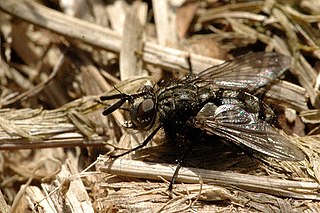
The Calliphoridae are a family of insects in the order Diptera, with almost 1,900 known species. The maggot larvae, often used as fishing bait, are known as gentles. The family is known to be polyphyletic, but much remains disputed regarding proper treatment of the constituent taxa, some of which are occasionally accorded family status.

The Anthomyiidae are a large and diverse family of Muscoidea flies. Most look rather like small houseflies. Most species are drab grey to black. Many Pegomya are yellow, and some members of the genera Anthomyia and Eutrichota are patterned in black-and-white or black-and-silvery-grey. Most are difficult to identify, apart from a few groups such as the kelp flies that are conspicuous on beaches.

Asplenium ceterach, also known as the rustyback fern, is a fern species in the spleenwort family Aspleniaceae.

Eriocrania chrysolepidella is a moth of the family Eriocraniidae found in Europe. It was first described by the German entomologist, Philipp Christoph Zeller in 1851. The larvae mine the leaves of hazel and hornbeam.

Stigmella crataegella is a moth of the family Nepticulidae found in Europe. It was described by the Austrian entomologist Josef Wilhelm Klimesch in 1936. The larvae mine the leaves of hawthorns.

Dialectica scalariella is a moth of the family Gracillariidae. It is found from France to the Iberian Peninsula, Italy and the Balkan Peninsula. Recently an imago was found in Great Britain. It was introduced in Australia for the biological control of the weed Echium plantagineum and has since spread to New Zealand.

Triarthria setipennis is a species of tachinid fly which parasitizes other insects, including earwigs.

Phytomyza ilicis, the holly leaf miner, is a leaf mining fly in the family Agromyzidae, whose larvae burrow into leaves of the holly tree leaving characteristic pale trails or leaf mines.

Compsilura concinnata is a parasitoid native to Europe that was introduced to North America in 1906 to control the population of an exotic forest, univoltine, spongy moth named Lymantria dispar. It is an endoparasitoid of larvae and lives with its host for most of its life. Eventually the parasitoid ends up killing the host and occasionally eating it. It attacks over 200 host species, mainly insects from the Orders: Coleoptera, Lepidoptera and Hymenoptera. Since this parasite has the ability to attack many different types of hosts, the organism has spilled over from the intended forest systems into other areas, like agricultural fields, affecting cabbage pests including the cabbage looper (Trichoplusia); the cabbage worm ; and even other invasive species such as the brown-tail moth. However, it also attacks native, non-pest insects such as the Cecropia moth and American moon moth.

Elachista cinereopunctella is a moth of the family Elachistidae found in Europe.

Asplenium adiantum-nigrum is a common species of fern known by the common name black spleenwort. It is found mostly in Africa, Europe, and Eurasia, but is also native to a few locales in Mexico and the United States.

Macquartia grisea is a European species of fly in the family Tachinidae.

Phytomyza horticola is a species of leaf-mining fly in the family Agromyzidae of the order Diptera. For a time it was treated as Chromatomyia horticola, but its original name has been restored after genus Chromatomyia was synonymized with Phytomyza. The species is a pest of high economic importance affecting the vegetable crops in temperate and tropical regions.

Paykullia maculata is a species of fly in the subfamily Rhinophorinae first described by Carl Fredrik Fallén in 1815.

Phytomyza ranunculi is a species of fly in the family Agromyzidae. It is found in the Palearctic.

Phytomyza plantaginis is a species of fly in the family Agromyzidae.

Psychoides verhuella is a moth of the family Tineidae found in Europe. It was first described in 1853, by Charles Théophile Bruand d'Uzelle from a specimen from Besançon, France. It is the type species of the genus Psychoides, also raised by Charles Bruand in 1853. The larvae feed on ferns.

Phytomyza stolonigena is a leaf mining fly in the family Agromyzidae, whose larvae burrow into leaves of Ranunculus. The larvae of the fly make characteristic mines in Ranunculus leaves; they mine in the petiole, making single corridors that fan out into the leaf blade.
Phytomyza ancholiae is a species of fly in the family Agromyzidae.in the Phytomyza minuscula group, along with Phytomyza aquilegivora.

Chromatomyia primulae is a species of leaf-mining fly in the family Agromyzidae, of the order Diptera. The larvae mine the leaves of Primula species. The fly was described by the French physician and entomologist, Jean-Baptiste Robineau-Desvoidy in 1851 and is found in Europe.



















